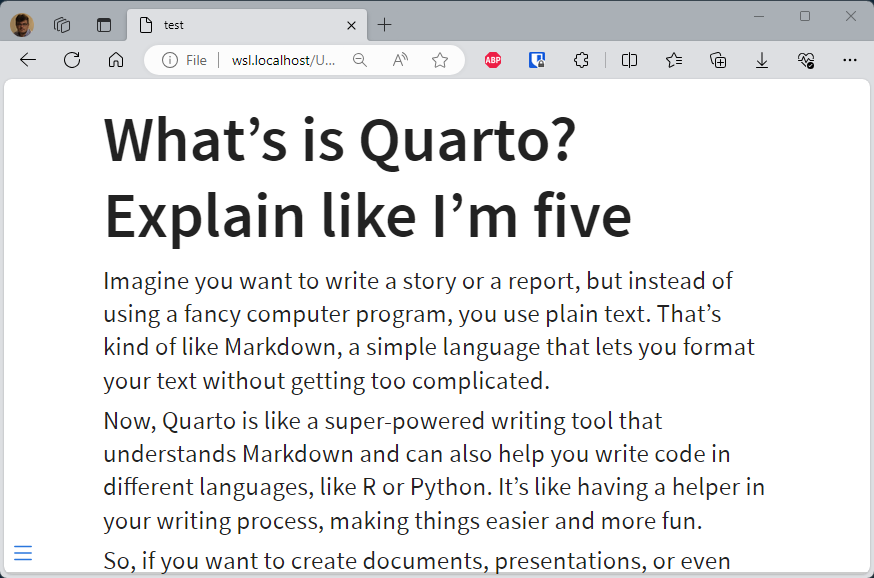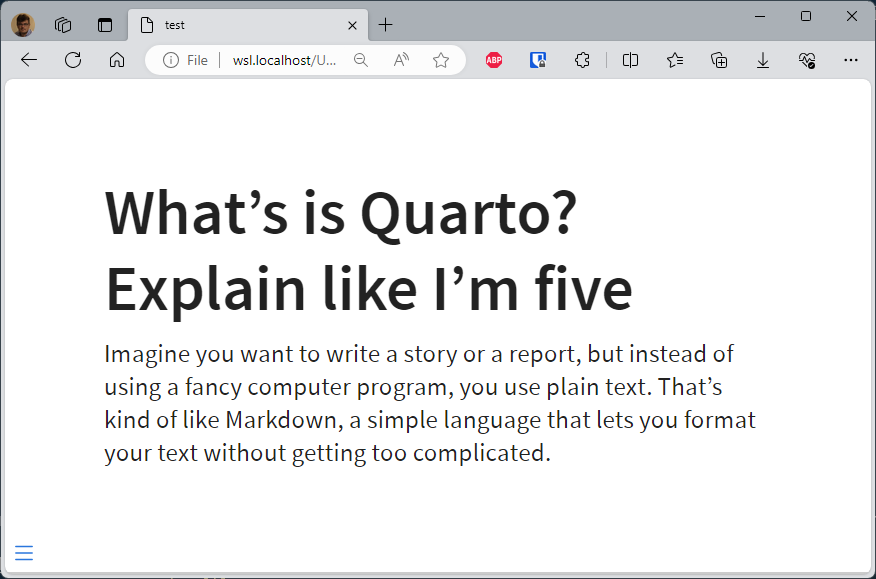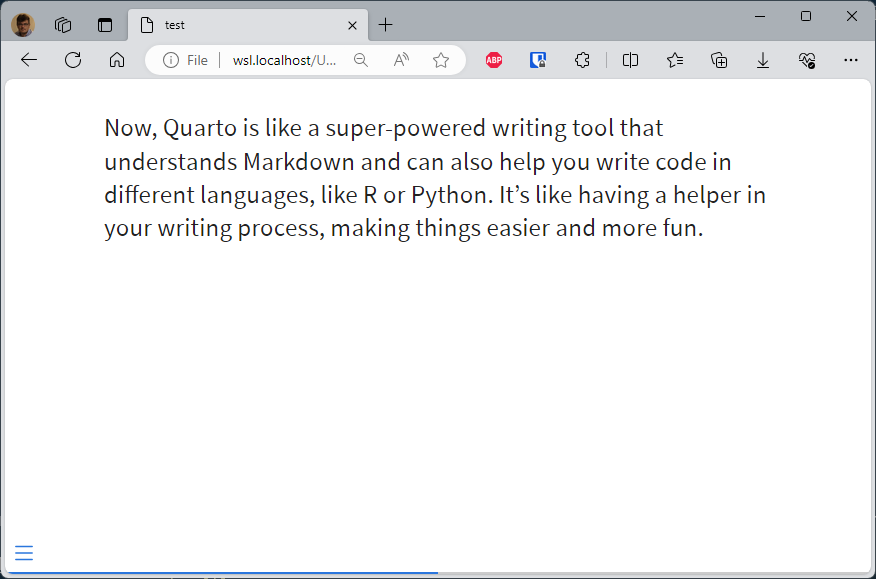Running Quarto Markdown in Docker

Quarto is a tool for producing PDF, Word document, HTML web pages, ePub files, slideshows and many, many more output based on a Markdown file.
Using Quarto, you can render any markdown content to a new PDF f.i.
Quarto supports a very large number of features, to which are added extensions from its community, making it a really practical tool for anyone wishing to produce documentation.
Personally, I haven't used a Word-type word processor for several years; nor have I used PowerPoint since, I don't even know when the last time was.
And yet, I produce a great deal of documentation and slideshows. I write everything in markdown and generate pdf or slideshows from the same content.
Until recently, I'd been using pandoc but, having taken the time to look around Quarto, it's a hell of a lot more powerful.
Like always on this blog, you will not install Quarto the old-fashioned way. Instead, you'll create our own Docker image.
Let's play
As usual, you will now create a temporary folder for your experiments. Please start a Linux shell and run mkdir -p /tmp/docker-quarto && cd $_.
Create your own Docker image
If you prefer to use an existing prebuilt image; jump to the next chapter.
Create a new file called Dockerfile (there is no extension) with this content:
# Based on https://github.com/analythium/quarto-docker-examples/blob/main/Dockerfile.base
# Version number of Quarto to download and use
ARG QUARTO_VERSION="1.4.529"
ARG OS_USERNAME=quarto
ARG UID=1000
ARG GID=1000
FROM eddelbuettel/r2u:20.04
# librsvg2-bin is to allow SVG conversion when rendering a PDF file
# (will install the rsvg-view binary)
RUN set -e -x && \
apt-get update && apt-get install -y --no-install-recommends \
pandoc \
pandoc-citeproc \
curl \
gdebi-core \
librsvg2-bin \
python3.8 python3-pip \
&& apt-get clean \
&& rm -rf /var/lib/apt/lists/*
RUN set -e -x && \
install.r shiny jsonlite ggplot2 htmltools remotes renv knitr rmarkdown quarto
# Download and install Quarto
ARG QUARTO_VERSION
RUN set -e -x && \
curl -o quarto-linux-amd64.deb -L https://github.com/quarto-dev/quarto-cli/releases/download/v${QUARTO_VERSION}/quarto-${QUARTO_VERSION}-linux-amd64.deb \
&& gdebi --non-interactive quarto-linux-amd64.deb \
&& rm -f quarto-linux-amd64.deb
# Should be done for the user; won't work if done for root
# (quarto will say that "tinytex is not installed")
ARG OS_USERNAME
ARG UID
ARG GID
RUN set -e -x && \
groupadd -g $GID -o "${OS_USERNAME}" && \
useradd -m -u $UID -g $GID -o -s /bin/bash "${OS_USERNAME}"
USER "${OS_USERNAME}"
# Install tools like tinytex to allow conversion to PDF
RUN set -e -x && \
quarto install tool tinytex --update-path
RUN set -e -x && \
printf "\e[0;105m%s\e[0;0m\n" "Run tlmgr update" \
&& ~/.TinyTeX/bin/x86_64-linux/tlmgr update --self --all && \
~/.TinyTeX/bin/x86_64-linux/fmtutil-sys --all
# See https://github.com/rstudio/tinytex/issues/426 for explanation
RUN set -e -x && \
printf "\e[0;105m%s\e[0;0m\n" "Run tlmgr install for a few tinyText packages (needed for PDF conversion)" \
&& ~/.TinyTeX/bin/x86_64-linux/tlmgr install fvextra footnotebackref pagecolor sourcesanspro sourcecodepro titling
USER root
RUN set -e -x && \
mkdir -p /input
USER "${OS_USERNAME}"
WORKDIR /
This done, please run docker build -t cavo789/quarto . and after something like three minutes the first time, you'll get your own Docker image:
❯ docker build -t cavo789/quarto .
[+] Building 208.2s (13/13) FINISHED docker:default
=> [internal] load .dockerignore 0.0s
=> => transferring context: 2B 0.0s
=> [internal] load build definition from Dockerfile 0.0s
=> => transferring dockerfile: 2.08kB 0.0s
=> [internal] load metadata for docker.io/eddelbuettel/r2u:20.04 3.4s
=> CACHED [ 1/10] FROM docker.io/eddelbuettel/r2u:20.04@sha256:133b40653e0ad564d348f94ad72c753b97fb28941c072e69bb6e03c3b8d6c06e 0.0s
=> [ 2/10] RUN set -e -x && apt-get update && apt-get install -y --no-install-recommends pandoc pandoc-citeproc curl gdebi-core librsvg2-bin python3.8 47.6s
=> [ 3/10] RUN set -e -x && install.r shiny jsonlite ggplot2 htmltools remotes renv knitr rmarkdown quarto 27.2s
=> [ 4/10] RUN set -e -x && curl -o quarto-linux-amd64.deb -L https://github.com/quarto-dev/quarto-cli/releases/download/v1.4.529/quarto-1.4.529-linux-amd64.deb && gdebi - 12.1s
=> [ 5/10] RUN set -e -x && groupadd -g 1000 -o "quarto" && useradd -m -u 1000 -g 1000 -o -s /bin/bash "quarto" 0.5s
=> [ 6/10] RUN set -e -x && quarto install tool tinytex --update-path 23.0s
=> [ 7/10] RUN set -e -x && printf "\e[0;105m%s\e[0;0m\n" "Run tlmgr update" && ~/.TinyTeX/bin/x86_64-linux/tlmgr update --self --all && ~/.TinyTeX/bin/x86_64-linux/fm 77.9s
=> [ 8/10] RUN set -e -x && printf "\e[0;105m%s\e[0;0m\n" "Run tlmgr install for a few tinyText packages (needed for PDF conversion)" && ~/.TinyTeX/bin/x86_64-linux/tlmgr 11.7s
=> [ 9/10] RUN set -e -x && mkdir -p /input 0.5s
=> exporting to image 4.0s
=> => exporting layers 4.0s
=> => writing image sha256:fe1d20bd71a66eb574ba1f5b35c988ace57c2c30f93159caa4d5de2f8c490eb0 0.0s
=> => naming to docker.io/cavo789/quarto 0.0s
What's Next?
View summary of image vulnerabilities and recommendations → docker scout quickview
The previous instruction docker build -t cavo789/quarto . has created an image called cavo789/quarto. You can for sure choose a different name without any impact on the image.
You can quickly check the size of your image; quite huge but except you're very low in memory / disk space; this is really not a big deal.
❯ docker image list | grep quarto
cavo789/quarto latest fe1d20bd71a6 10 minutes ago 2.14GB
Use an existing image
There are a number of images on the Internet to suit your needs. You'll find them at https://gitlab.com/quarto-forge/docker. The so-called Tier 0 image is suitable for generating html / revealjs output.
If you use the Tier 0 image, here is the command to use: docker run -it --rm -v .:/public -w /public -u $(id -u):$(id -g) registry.gitlab.com/quarto-forge/docker/quarto quarto render xxx
Using Quarto and generate a PDF file
Create a new test.md file in your /tmp/docker-quarto folder with this content:
# What's is Quarto? Explain like I'm five
Imagine you want to write a story or a report, but instead of using a fancy computer program, you use plain text. That's kind of like Markdown, a simple language that lets you format your text without getting too complicated.
Now, Quarto is like a super-powered writing tool that understands Markdown and can also help you write code in different languages, like R or Python. It's like having a helper in your writing process, making things easier and more fun.
So, if you want to create documents, presentations, or even books, Quarto and Markdown can be your friends. They'll help you organize your thoughts, add cool features, and even share your work with the world.
Now, back to your Linux console and you'll convert that file to a pdf. Please refers to the official documentation of Quarto to get in-depth information about it.
To convert to a PDF, the instruction to fire is quarto render test.md --to pdf. But since you're using Quarto from a Docker image, the instruction becomes docker run -it --rm -v .:/input -w /input -u $(id -u):$(id -g) cavo789/quarto quarto render test.md --to pdf.
As a reminder, the used Docker run command are (almost always the same):
-itto start Docker interactively, this will allow the script running in the container to ask you for some prompts f.i.,--rmto ask Docker to kill and remove the container as soon as the script has been executed (otherwise you'll have a lot of exited but not removed Docker containers; you can check this by not using the--rmflag then runningdocker container liston the console),-v .:/inputto share your current folder with a folder called/inputin the Docker container,-w /inputto tell Docker that the current directory, in the container, will be the/appfolder,-u $(id -u):$(id -g)ask Docker to reuse our local credentials so when a file is updated/created in the container, the file will be owned by you,- then
cavo789/quartowhich is the name of your Quarto Docker image, and, finally, quarto render test.md --to pdfi.e. the command line to start within the container.
So, let's convert to PDF and run docker run -it --rm -v .:/input -w /input -u $(id -u):$(id -g) cavo789/quarto quarto render test.md --to pdf in your console.
❯ docker run -it --rm -v .:/input -w /input -u $(id -u):$(id -g) cavo789/quarto quarto render test.md --to pdf`
pandoc
to: latex
output-file: test.tex
standalone: true
pdf-engine: xelatex
variables:
graphics: true
tables: true
default-image-extension: pdf
metadata
documentclass: scrartcl
classoption:
- DIV=11
- numbers=noendperiod
papersize: letter
header-includes:
- '\KOMAoption{captions}{tableheading}'
block-headings: true
Rendering PDF
running xelatex - 1
This is XeTeX, Version 3.141592653-2.6-0.999995 (TeX Live 2023) (preloaded format=xelatex)
restricted \write18 enabled.
entering extended mode
running xelatex - 2
This is XeTeX, Version 3.141592653-2.6-0.999995 (TeX Live 2023) (preloaded format=xelatex)
restricted \write18 enabled.
entering extended mode
Output created: test.pdf

Add the --log-level warning CLI argument to Quarto to ask him to show only warning (and error) messages. Non-essential output will be hidden and you'll keep a clean console. The new command to use is thus docker run -it --rm -v .:/input -w /input -u $(id -u):$(id -g) cavo789/quarto quarto render test.md --to pdf --log-level warning
Using Quarto and generate a HTML file
Simply modify the --to argument and replace pdf by html and run the command: docker run -it --rm -v .:/input -w /input -u $(id -u):$(id -g) cavo789/quarto quarto render test.md --to html --log-level warning
Now, you've a test.html file in your directory.
Using Quarto and generate a revealjs slideshow
This time, the --to argument should be set to revealjs: docker run -it --rm -v .:/input -w /input -u $(id -u):$(id -g) cavo789/quarto quarto render test.md --to revealjs --log-level warning
Open the test.html file and you'll get this:

Ok, you've just one slide now. Reopen the test.md file and you'll insert slide breaks. This can be done using the ---- syntax:
# What's is Quarto? Explain like I'm five
Imagine you want to write a story or a report, but instead of using a fancy computer program, you use plain text. That's kind of like Markdown, a simple language that lets you format your text without getting too complicated.
----
Now, Quarto is like a super-powered writing tool that understands Markdown and can also help you write code in different languages, like R or Python. It's like having a helper in your writing process, making things easier and more fun.
----
So, if you want to create documents, presentations, or even books, Quarto and Markdown can be your friends. They'll help you organize your thoughts, add cool features, and even share your work with the world.
Rerun docker run -it --rm -v .:/input -w /input -u $(id -u):$(id -g) cavo789/quarto quarto render test.md --to revealjs --log-level warning and now your slideshow will have three slides (press space or arrow keys for navigation):



The nice thing now is that your slideshow is ready to be deployed on your remote server. Copy the html file and the associated folder (in our use case here, file test.html and folder test_files) to your FTP server f.i. and your website can be publicly accessed. Nice, isn't it?